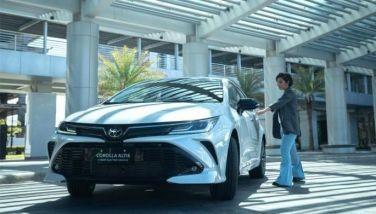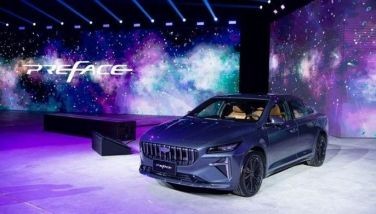The future of mobility according to Toyota
July 6, 2005 | 12:00am
Toyota currently has the enviable position of being the market leader in the Philippine automotive industry. Their IMV-platform-based vehicles — the Hilux pickup, the Innova multi-purpose vehicle (MPV)-cum-AUV and the Fortuner SUV — boasts of a long waiting list of buyers. Their Toyota Camry continues to lord it over the premium Japanese sedan market while their Altis and Vios continue to enjoy brisk sales in their respective categories. Even the van market is effectively covered by their Hi-Ace, Grandia and Previa models and there are speculations that Toyota Motor Philippines Corporation (TMPC) might bring in the Lexus premium brand in the near future.
The situation is the same globally where Toyota has reportedly overtaken the Ford Motor Company as the second largest automaker in the world while targeting the Number One spot currently held by General Motors. In Japan, Toyota has also diversified into housing, intelligent transport systems (ITS), information and communications, financial activities, marine craft and biotechnology-related business. The company is even actively involved in Formula One as well as in the American open-wheel racing series, truck racing and other motor sports endeavors. With such an array of achievements, what more can Toyota aspire for?
As if to answer this question, Toyota brought several local motoring and business journalists, including yours truly, along with the corporate and fleet customers of TMPC to the 2005 Aichi Expo in the Nagakute Area and Seto Area in Nagoya, Japan to witness the company’s presentation in the ecologically-sound Toyota Pavilion, as well as indulge their guests in a whirlwind tour of Nagoya, Kyoto and Tokyo.
Toyota is predicting that the future will be ripe for personal mobility. They recognize the need for individuality and reasoned that people often drive alone in their cars that can easily carry four or five passengers, thus using the vehicle inefficiently. Toyota foresees that people will be inclined more to travel by themselves and designed an intelligent single passenger personal mobility vehicle called the "i-unit".
The i-unit only takes up little more space than a standing person and has low energy consumption. The components are made with decomposable and recyclable materials to reduce environmental impact. Minimizing its mechanical origins and design, the i-unit features a leaf-inspired organic design to express its harmony with nature. It has a variable positioning system that changes the vehicle’s height depending on the speed as dictated by the driving environment. In low speed mode, the i-unit moves leisurely, with the passenger cell in upright position, making the driver’s eye level even with that of people standing. In high-speed mode, the passenger cell reclines to lower the center of gravity and to ensure stable handling, which allows the i-unit to offer seamless transportation over any type of driving environment.
Toyota’s i-unit features a personal recognition system that distinguishes passengers by their palms and face, and a driver monitor system that provides music and information according to the driver’s emotion, physical condition and preferences. The body color can also be customized with light emitting diodes (LED). An IT Controller transmits various driver support information using sound, light and vibration, and a display system detects and superimposes vehicle position over an actual view of the driving environment. These features allow for intuitive, user-friendly and realistic communication with the i-unit.
Independent left and right front wheel steering controls and rear in-wheel motors enable the passenger to drive at high speed and maneuver the i-unit in a 180-degree on-the-spot turn. A drive-by-wire drive controller allows the driver to go anywhere, controlling speed and direction with just one hand and featuring a user-friendly system that follows the driver’s directions; when pushed forward the vehicle goes forward and when pushed left the vehicle makes a left turn.
Toyota designed the i-unit’s IT to work with an Intelligent Transport System that detects vehicle surroundings with various sensors and communicates vehicle position with other cars and road infrastructure to provide safe and comfortable driving while preventing accidents before they happen. The i-unit normally operates in manual drive but automated driving is possible in dedicated lanes.
Toyota likewise unveiled a drastically innovative way of mobilization — a two-legged walking robot that they called the "i-foot". The driver/passenger mounts and drives the i-foot in an egg-shaped passenger cell. The robot offers three-dimensional mobility: it can go backward and forward, side-to-side and up and down a flight of stairs. Toyota claims that the egg-shaped cocoon is designed to give a feeling of safety and reliability. The bird-like legs bend toward the back, lowering the seat for passenger mounting and dismounting while giving the i-foot a distinct look to its walk.
A rechargeable lightweight lithium-ion battery mounted in the cabin minimizes the i-foots overall weight and a low-battery system notifies the passenger to stop the vehicle’s operation. A joystick on the right hand armrest allows the driver/passenger to intuitively and easily control the speed and direction while a battery level display and illumination switch are located on the instrument panel on the left armrest. To safely back the i-foot, it is equipped with the same rear view monitor used in automobiles with sensors that detect people and cars behind.
Along with the i-unit and the i-foot, Toyota also showcased its line of "Partner Robots", in bi-ped (two-legged) and wheeled rolling models. The walking model represents a form familiar to humans and is able to do various jobs with its hand and artificial lips, like play a clarinet, saxophone or trumpet. The wheeled model can move quickly, turn in place and change directions nimbly and smoothly in small spaces, as well as do various jobs with its hands.
The robots reminded me of Asimo, Honda’s then-innovative technological robotic showcase. Toyota, which has developed a nasty habit of one-upmanship, has upped the ante again, not only in sales and vehicle models, but even in future concepts, out-performing Honda and other car brands in more ways than one. Perhaps, this is Toyota’s way of showing the world that it is equipped with a lot of innovation to help it attain its goal of becoming the world’s No.1, not only in automobiles but in future mobility technology as well.
The situation is the same globally where Toyota has reportedly overtaken the Ford Motor Company as the second largest automaker in the world while targeting the Number One spot currently held by General Motors. In Japan, Toyota has also diversified into housing, intelligent transport systems (ITS), information and communications, financial activities, marine craft and biotechnology-related business. The company is even actively involved in Formula One as well as in the American open-wheel racing series, truck racing and other motor sports endeavors. With such an array of achievements, what more can Toyota aspire for?
As if to answer this question, Toyota brought several local motoring and business journalists, including yours truly, along with the corporate and fleet customers of TMPC to the 2005 Aichi Expo in the Nagakute Area and Seto Area in Nagoya, Japan to witness the company’s presentation in the ecologically-sound Toyota Pavilion, as well as indulge their guests in a whirlwind tour of Nagoya, Kyoto and Tokyo.
The i-unit only takes up little more space than a standing person and has low energy consumption. The components are made with decomposable and recyclable materials to reduce environmental impact. Minimizing its mechanical origins and design, the i-unit features a leaf-inspired organic design to express its harmony with nature. It has a variable positioning system that changes the vehicle’s height depending on the speed as dictated by the driving environment. In low speed mode, the i-unit moves leisurely, with the passenger cell in upright position, making the driver’s eye level even with that of people standing. In high-speed mode, the passenger cell reclines to lower the center of gravity and to ensure stable handling, which allows the i-unit to offer seamless transportation over any type of driving environment.
Toyota’s i-unit features a personal recognition system that distinguishes passengers by their palms and face, and a driver monitor system that provides music and information according to the driver’s emotion, physical condition and preferences. The body color can also be customized with light emitting diodes (LED). An IT Controller transmits various driver support information using sound, light and vibration, and a display system detects and superimposes vehicle position over an actual view of the driving environment. These features allow for intuitive, user-friendly and realistic communication with the i-unit.
Independent left and right front wheel steering controls and rear in-wheel motors enable the passenger to drive at high speed and maneuver the i-unit in a 180-degree on-the-spot turn. A drive-by-wire drive controller allows the driver to go anywhere, controlling speed and direction with just one hand and featuring a user-friendly system that follows the driver’s directions; when pushed forward the vehicle goes forward and when pushed left the vehicle makes a left turn.
Toyota designed the i-unit’s IT to work with an Intelligent Transport System that detects vehicle surroundings with various sensors and communicates vehicle position with other cars and road infrastructure to provide safe and comfortable driving while preventing accidents before they happen. The i-unit normally operates in manual drive but automated driving is possible in dedicated lanes.
A rechargeable lightweight lithium-ion battery mounted in the cabin minimizes the i-foots overall weight and a low-battery system notifies the passenger to stop the vehicle’s operation. A joystick on the right hand armrest allows the driver/passenger to intuitively and easily control the speed and direction while a battery level display and illumination switch are located on the instrument panel on the left armrest. To safely back the i-foot, it is equipped with the same rear view monitor used in automobiles with sensors that detect people and cars behind.
Along with the i-unit and the i-foot, Toyota also showcased its line of "Partner Robots", in bi-ped (two-legged) and wheeled rolling models. The walking model represents a form familiar to humans and is able to do various jobs with its hand and artificial lips, like play a clarinet, saxophone or trumpet. The wheeled model can move quickly, turn in place and change directions nimbly and smoothly in small spaces, as well as do various jobs with its hands.
The robots reminded me of Asimo, Honda’s then-innovative technological robotic showcase. Toyota, which has developed a nasty habit of one-upmanship, has upped the ante again, not only in sales and vehicle models, but even in future concepts, out-performing Honda and other car brands in more ways than one. Perhaps, this is Toyota’s way of showing the world that it is equipped with a lot of innovation to help it attain its goal of becoming the world’s No.1, not only in automobiles but in future mobility technology as well.
BrandSpace Articles
<
>
- Latest
Latest
Latest
October 4, 2024 - 6:00am
October 4, 2024 - 6:00am
September 30, 2024 - 4:26pm
By EC Toledo | September 30, 2024 - 4:26pm
September 26, 2024 - 3:30pm
September 26, 2024 - 3:30pm
August 16, 2024 - 11:00am
By Euden Valdez | August 16, 2024 - 11:00am
Recommended

























